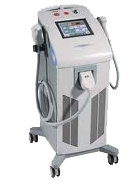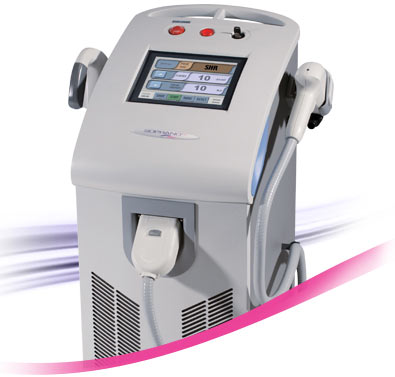 Tired Of Tweezing, Shaving Or Waxing?
Tired Of Tweezing, Shaving Or Waxing?
For long-lasting reduction of unwanted hair anywhere on the face or body, the Soprano Diode Laser offers a virtually painless, efficient and affordable alternative.
At The Lazer Room
- All patients are screened by the doctor
- We treat both light and dark skin types
- Hormonal testing may be provided for abnormal facial hair (hirsutism)
- We offer the best value in St John’s, with special rates for students.
Hair Removal lasers have been in use since 1997 and have become popular because of the speed and efficiency of the process- a medical study conducted in 2000 concluded that lasers were 60 times faster, less painful and more reliable than electrolysis for the removal of dark coarse hair.
Lasers work by a process of selective photothermolysis; the light energy produced by the laser is taken up by the melanin (pigment)-producing cells located around the hair follicle and is converted into heat, causing a destruction of the follicle. Multiple treatments, usually 6-9, occasionally more, depending on the type of hair and skin colour, are required to provide long-term reduction of hair. Treatments are spaced 4-8 weeks apart for most areas because the laser will only target hairs in the active growing phase (anagen). Ideally, the spacing of treatments should be guided by the individual’s response; it is best to wait until shedding of the treated hairs has occurred (usually complete within 2-3 weeks), followed by regrowth of enough hair to warrant another treatment.
 It is important to note that lasers cannot treat grey, light blond or light red hair, and are not effective on fine vellus (peach fuzz) hair.
It is important to note that lasers cannot treat grey, light blond or light red hair, and are not effective on fine vellus (peach fuzz) hair.
There are 2 types of melanin in hair – eumelanin, which gives hair a brown or black appearance and phaeomelanin, which gives hair a blond or reddish coloration. Laser energy is selectively absorbed by eumelanin- hence its relative ineffectiveness in targeting light hair.
The most efficient combination for treatment is pale skin and coarse dark hair, although the Soprano laser can safely and effectively treat dark-skinned individuals (and is FDA cleared for all skin types).
Several different types of lasers can be used for hair removal:
- Diode Lasers (Soprano laser used for all laser hair removal at The Lazer Room) Treats light and dark skin types
- Alexandrite Lasers Treat finer hair and lighter skin types
- NdYag lasers Are safer for very dark skin types, however, are less effective at hair removal.
- IPL (Intense Pulsed Light, not considered a true laser), are often used for types light to medium skin types, they risk burns on medium dark skin types.
- Laser treatments should not be undertaken within 4 weeks of active suntanning or use of sunbeds because of the risk of burning or hyperpigmentation of the area exposed to UV light; if you are planning a holiday in the sun, discuss the timing of your treatments first. Your treatments can be halted 2-4 weeks before going away, and safely resumed 4 weeks after return. You will be advised to use SPF 50 or higher on the treated areas if exposing them to the sun, to avoid hyperpigmentation.
- Individuals who have been using spray-on tans or self-tanning creams must also postpone treatment until the colour has faded
- You should not undertake laser treatments within 4-6 weeks of waxing the area to be treated: waxing damages the hair follicle, we require an intact hair follicle to treat; also the trauma to the area may put you at risk of hyperpigmentation of the skin.
- Discuss any medications, herbals or supplements you are taking with the doctor; some medications may be photosensitizing, and put you at risk of burning.
- Do not use any perfumed products eg shower gels, moisturisers, 24 hrs prior to treatment, as some perfumes may provoke a phototoxic reaction.
- Laser treatments are contraindicated within 1 year of taking Accutane, a medication prescribed for the treatment of acne.
- We do not treat pregnant women, although there is no data to suggest that laser hair removal would be harmful to a developing fetus, we believe it is better to air on the side of caution.
- Lasers cannot be used over a tattoo, as some tattoo dyes will darken with exposure to certain wavelengths of light.
- If you are susceptible to cold sores and are having laser treatments on the face, it may be advisable to take a prophylactic medication such as Valtrex to prevent a recurrence, as the virus remains dormant in your body and may be re-activated by laser treatments. We will not treat an area where there is an active cold sore, other infection or skin irritation.
- If you are menstruating, kindly postpone your bikini treatment until your cycle is complete.
The area to be treated must be shaved 1-2 days prior to your treatment as long hairs will singe when exposed to the laser! A small amount of stubble is acceptable; the laser will penetrate the skin targeting the melanin-producing cells at the base of the hair follicle; hence laser hair removal is useful for conditions involving ingrown hairs, such as pseudofolliculitis barbae (ingrown hairs in beard area), or pilonidal cysts (ingrown hairs at the base of the spine).
You will be required to wear proper protective eyewear at all times during the procedure.(eyewear will be provided)
Comfort Levels
The Soprano laser employs a Dual Chill Sapphire Crystal Tip for contact cooling of the skin; it is rare that discomfort exceeds the level of a warm (pins and needles) sensation, some areas are more sensitive than others – eg. upper lip, underarm, bikini area. For additional comfort, we use a Zimmer Chilling Machine to blow chilled air on the treatment area.
Additionally, the Soprano Diode laser has a unique setting, SHR mode, that allows us to “stack” pulses at a low fluence and gradually heat up the hair follicle to the proper damage point. This allows us to offer very comfortable treatments for large surface areas such as legs, back etc.
If you are concerned about sensitivity in smaller areas (see above) -discuss the use of a topical anaesthetic gel with the physician prior to your treatment.
We do not advise the use of such gels on larger areas such as the back or legs, due to the risk of lidocaine toxicity.
What To Expect Immediately Following A Treatment
The area may be slightly red immediately after treatment this is a temporary effect which is usually gone within 20 mins. If the treated hair is very dark and coarse, there may be a slight swelling around each follicle, a (goosebump type) effect known as perifollicular oedema, which again is a temporary effect. Very rarely, a small crust may form around the treated follicle, which will disappear in a couple of days. A mild sunburn feeling may be experienced by darker skin types which will resolve very quickly with application of aloe vera gel or ice. Hair will shed within 2-3 weeks of treatment, but a percentage will regrow; leading to a net average loss of 20-25% by the time your next treatment is due.
Hyperpigmentation or Hypopigmentation
Olive skinned individuals, or those with recent suntans or exposure to the sun after treatment, may be at a slight risk of developing darker pigmentation known as Hyperpigmentation in the treated areas.
Dark skinned individuals have a small risk of loss of pigmentation known as Hypopigmentation in treated areas. If you have dark skin and have experienced a change in skin colour around a scar or in areas of the skin affected by acne, you may be at risk of this happening following laser treatment. A test patch can be done to observe the reaction of the skin prior to a full treatment session.
Treatment Response
If we do not see a response to the first treatment, we will increase the treatment parameters until we see a suitable skin response; some people may require more treatment sessions than others, especially those with darker skin, or lighter hair.
The principle behind laser hair removal is to deliver enough energy to the growing hair follicle to permanently damage it: regrowth of a hair would mean that insufficient energy was absorbed by that follicle to result in destruction; reasons for this would be:
- Insufficient energy absorbed because too little pigmentation in the hair to act as a target– ie very light- coloured hair to start with
- Insufficient energy delivered to kill the hair follicle because of caution with using high settings on dark- skinned individuals. In dark – skinned individuals, the melanin in the skin is also targeted by the laser; so we must use lower energy settings to avoid the risk of thermal injury (blistering) or hypopigmentation of the skin. These lower energy settings may result in shrinking of the follicle, vs destruction – thus the person may experience a regrowth of very fine, light coloured hair (vellus hair). These individuals will typically require more than the average number of sessions for clearance.
- Hormonal disorders associated with hirsuitism (dark coarse hair on the face, neck, chest, abdominal strip in females).The influence of excessive levels of androgenic hormones may lead to the growth of abnormally coarse dark hairs in these areas. The doctor will inquire into other symptoms (eg. irregular periods, infertility, weight gain, acne) and order corresponding blood tests to screen for disorders such as Polycystic ovarian syndrome, disorders of the adrenal gland etc (see Skin- hirsuitism)
- Maintenance treatments may be required once or twice a year, for a small percentage of people, this is due to the maturation of dormant hair follicles in the previously treated area. As mentioned at the beginning of the section, lasers target follicles which are in the active growth phase, vs the resting phase; resting follicles may mature years later to produce coarse terminal hairs.
- Paradoxical hair growth is a rare phenomenon, seen occasionally in ladies of Middle Eastern or Mediterranean ethnicity who are having laser treatments for facial hair. The areas bordering the treatment zone may develop some dark hairs; this is thought to be due to scattering of low-level laser energy outside the treatment zone, resulting in stimulation, vs destruction, of the hair follicles (see LLLT for alopecia) usually treatment of the affected areas at higher parameters will resolve this issue.
